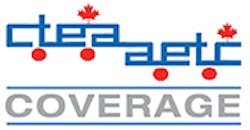We are only as good as the tools we use. Increasingly the tools truck body and trailer manufacturers use are digital instead of cast iron.
Not surprisingly, technology was the emphasis in this year’s trailer forum, presented during the annual CTEA Manufacturer’s Conference in Vancouver, British Columbia. The session featured several speakers who provided updates on some of the most useful digital tools that are being used today.
“We need some way to convey to the shop floor what we have in mind and to create it consistently and repeatedly,” Mizgala said. “Not everyone is an artist who can draw a straight line and circle without a ruler or a compass.”
Mizgala particularly appreciates CAD software with three-dimensional capability that allows the drawing to be rotated and presented to the shop floor or to customers. He said there were plenty of choices in software vendors and prices. Among the capabilities he praised:
• New sheet metal functions that allow for automatic flattening and bend allowances.
• Property management that generates bills of materials.
• The ability to render and animate for greater visualization.
• Basic simulation for finite element analysis.
• Engineering toolboxes for quick calculations.
• Configurations for parts or assemblies that can be driven either by an Excel table or a menu.
• A parts library of standard steel shapes, fasteners, and other generic items.
• A beam generator for weldments that allows a complex frame to be created quickly from a 2D or 3D sketch.
Mizgala touched on data management capabilities of new software that makes it possible to build a centralized data vault of drawings, enabling multiple users to collaborate on subassemblies and large projects. The software keeps a history of the work, making it possible to return to previous designs.
With a good CAD program, manufacturers can add additional capabilities such as computer-aided engineering and computer-aided manufacturing, data management, and utilities such as task scheduler.
“A small investment in researching some of the third-party add-ons could yield considerable savings in time and productivity,” Mizgala said.
Putting ERP into practice
Jean Magny, Genius Solutions, presented the pluses and minuses of enterprise resource planning (ERP).
How can an ERP integrate into manufacturing:
• By creating a bill of materials (BOM) through the Product Configurator during the sales process.
• By scheduling resources by being better able to consider capacity and material availability.
• By sharing job progression as tasks are being completed.
• By identifying potential shortages before releasing the jobs on the floor.
• By collecting live data from the shop floor for job progression, job costing, and payroll
• Standardization of design templates.
Disadvantages of a ERP system:
• Success depends greatly on the skill and experience of the workforce—including education and making the system work properly.
• Resistance in sharing internal information between departments can reduce the efficiency of the software.
• The benefits of having an ERP system are not present immediately after the implementation of the software
“Implementing ERP will be a disruptive project,” Magny said. “Establish your main goals and not ‘oversell yourself. And recognize that you are implementing a culture, not simply installing software.”
Is 3D for you?
Additive manufacturing—also known as 3D printing—has become a popular topic of discussion among manufacturers, but is it appropriate for the commercial truck and trailer industry?
In his presentation at the trailer forum, Dubi Finklshtein with Javelin Technologies said that the sweet spot for additive manufacturing is in producing high complexity, low quantity parts. Specialty end-use parts, along with tooling are among the other common applications.
“Any company involved in the design and manufacture of physical products using 3D software or 3D content can also use 3D printing,” he said.
Uses include concept modeling, functional prototyping, manufacturing, high end prototyping, manufacturing support and production.
One major advantage of additive manufacturing is design freedom, Finklshtein said. The technology is capable of producing products with variable wall thicknesses, complex honeycombs, non-linear holes, and other complex shapes.
By being able to produce parts on demand, additive manufacturing promises to transform workflows.
“Lean, agile supply chains save money and time,” Finklshtein said. “Stockless supply chains are possible with digital inventory. Localized or in-house manufacturing can create supply without the chain.”
Discovering new talent
Manufacturers need to be cautious, however, as they implement new ways of doing things, according to Tony Nathan with K-Line Trailers LTD.
“You will do well when you expand your horizons,” Nathan said, “but you need to keep a foot in old technology.”
The last couple of years have been challenging for manufacturers in British Columbia and Alberta. K-Line Trailers, a specialty trailer manufacturer in Langley, British Columbia, has responded by utilizing existing tools more effectively.
“We increased capability and are performing more tasks in-house,” he said. “When we do things in house, our schedule becomes top priority—we aren’t at the mercy of someone else’s production schedule. We also have reduced our costs.”
Word of K-Line’s new capabilities soon got out, and now the company is offering custom fabrication services to customers in the area.
The company is also utilizing its workforce more effectively.
“We discovered that some of our employees have skills and hobbies that made them more valuable to us,” Nathan said. “And sometimes, because of what they have learned outside their jobs, they have given us a new take on existing technology.” ♦
For more information on Canadian Transportation
Equipment Association check out CTEA.
About the Author
Bruce Sauer
Editor
Bruce Sauer has been writing about the truck trailer, truck body and truck equipment industries since joining Trailer/Body Builders as an associate editor in 1974. During his career at Trailer/Body Builders, he has served as the magazine's managing editor and executive editor before being named editor of the magazine in 1999. He holds a Bachelor of Journalism degree from the University of Texas at Austin.
Rick Weber
Associate Editor
Rick Weber has been an associate editor for Trailer/Body Builders since February 2000. A national award-winning sportswriter, he covered the Miami Dolphins for the Fort Myers News-Press following service with publications in California and Australia. He is a graduate of Penn State University.





